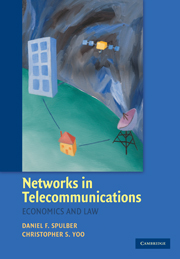Book contents
1 - The Structure and Functions of Networks
Published online by Cambridge University Press: 05 June 2012
Summary
Economic life is critically dependent on a wide variety of privately owned networks: for communications (the Internet and broadband data, telephone, broadcast television and radio, cable television), for transportation (airlines, railroads, buses, trucks, shipping, electric power transmission and distribution, natural gas and petroleum pipelines), and for distribution of products (wholesale trade and postal services). Although different types of networks vary significantly with respect to a wide variety of technical details, they share certain technical and economic features that are critical to understanding network access.
This chapter introduces some basic aspects of network structure and design. The focus of our discussion is on physical networks, involving facilities such as telecommunications switching equipment and transmission lines. The purpose is not only to provide a technical background to our study but also to obtain some important insights into how networks are organized. Evaluating the effects of regulation on the organization or formation of networks is central to our public policy analysis.
This chapter also introduces a classification scheme that is useful for understanding the different types of access to networks. These types of access have generated a variety of public policy actions. Classifying the types of access provides insights into inconsistencies in public policies that can create economic inefficiencies. Our classification scheme provides the basis for the development of a new Coasian theory of communications networks.
- Type
- Chapter
- Information
- Networks in TelecommunicationsEconomics and Law, pp. 13 - 38Publisher: Cambridge University PressPrint publication year: 2009



